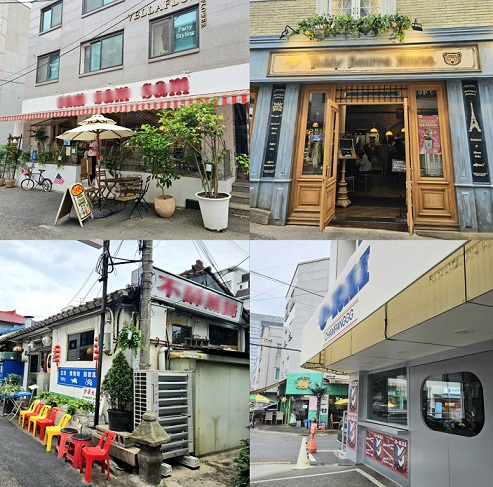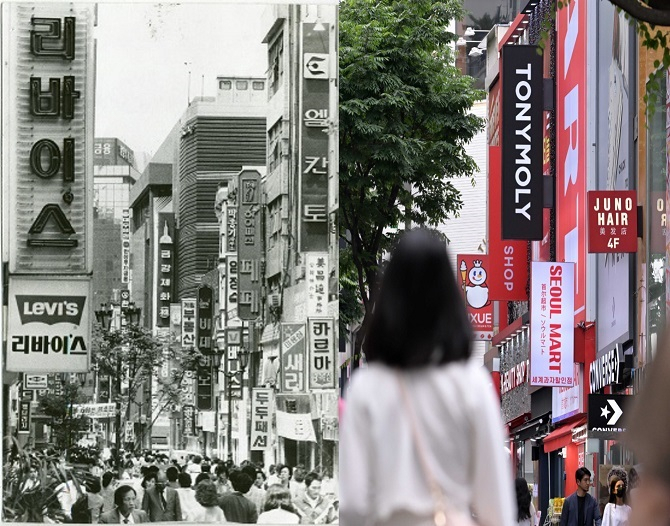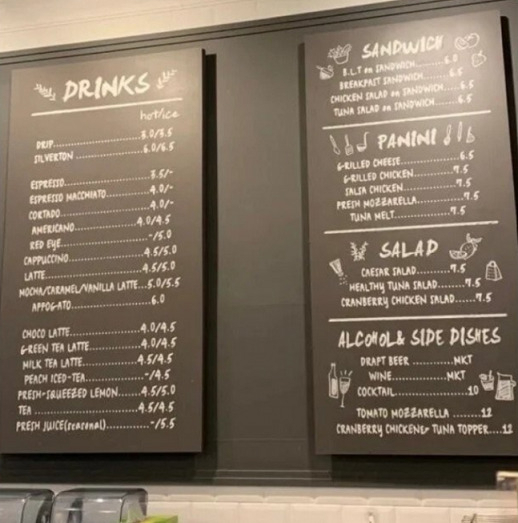
In one up-and-coming neighborhood in Seoul, the prevalence of English letters on cafe and restaurant signboards adds to its exotic ambiance, complementing the diverse range of foreign cuisines found there.
Approximately 7 out of 10 signboards in this area, known as Yongridan-gil and situated between Samgakji and Sinyongsan subway stations in central Seoul, are exclusively written in foreign languages. English is the most commonly used, followed by Chinese and Japanese.
As one strolls through this neighborhood, it is easy to mistake it for a different part of the world, if not for the pedestrians conversing in Korean.
Yongridan-gil may be just a trendy hot spot for young people in South Korea, but for those who are concerned, it is another indication of Hangeul’s waning presence in everyday signage within its homeland.
What happened?

When one compares photos of a street in Seoul’s Myeong-dong from the late '80s to the present day, it becomes clear: the English alphabet has ousted Hangeul from outdoor signage.
Comprehensive data on the use of foreign language in outdoor signage is not available. But a 2019 study from the Hangul Cultural Solidarity put the number of signboards written in only foreign languages in 12 of Seoul’s 25 districts at 1,704 that year, accounting for 23.5 percent of the 12-district total.
Signboards written in both Korean and foreign languages took up another 15.2 percent.
Outdoor signs written only in foreign languages are, in fact, against the law.
Under the Management of Outdoor Advertisements Act, shop banners should principally be written using Hangeul. If it is necessary to use foreign characters, the corresponding Korean letters should also be presented on the signboard in brackets.
A violation of this rule could result in a fine of up to 5 million won ($3,800), unless the foreign language signage is a registered trademark under the Korean Intellectual Property Office, in which case exceptions may be allowed.
This rule, however, is rarely enforced.
Back in 2002, a group of local organizations committed to protecting the Korean language mounted a campaign to change that.
They filed a damage compensation suit against telecoms firm KT Corp. and KB Kookmin Bank, taking issue with their changing of corporate logos to the current ones using English letters.
In 1997, KT’s Korean name, Hankuk Tongshin, was officially dropped from the company logo as it chose to exclusively go by KT, short for Korea Telecom. In 2001, the English letters “KB” replaced KB Kookmin Bank’s Korean name, Kookmin Eunhaeng, in the bank's logo.
The Seoul Central District Court acknowledged the illegitimate nature of the two corporate logos in question, but it did not support the complainants' argument for compensation.
“Advertisements entirely in the English alphabet violate the act on the management of outdoor advertisements stipulating that foreign language advertising materials should include Korean characters,” the court said in its ruling.
In dismissing the plaintiffs' claims for damages, the court stated that the Romanized logos affect public interest rather than individual rights.
“Since the violated rights pertain to social benefits rather than individual rights, it is not possible to hold (KT Corp. and KB Kookmin Bank) responsible for compensating individuals for any psychological harm (caused by corporate logos in English),” the court said.
The Korean Language Society, one of the groups involved in the 2002 campaign, says that the influence of foreign languages has only increased since losing the campaign.
Now, it is not limited to corporate logos, ads and shop signboards but has expanded to the public sector, the group said.
“Promoting (something) with foreign language slogans has become a common practice in both private and public spheres. Even state-run corporations or public events are being renamed in English,” a spokesperson at the civic group told The Korea Herald.
For example, a large banner displayed outside the Seoul Government Complex to promote the country’s bid to host the 2030 World Expo in Busan was written entirely in English, the representative said.
“Korea’s cultural power is stronger than ever, as seen in the global Korean pop and media content boom. It is deplorable that we are belittling our own language while more people around the globe are paying attention to the Korean language,” the spokesperson said.
Some experts say existing regulations, even if strictly enforced, would have done little to prevent Seoul from becoming a sea of non-Korean advertisements and signboards.
“According to the law, a signboard that covers an area of 5 square meters or less and is installed on a building with four floors above ground or less is not subject to the regulation," said Kim Yang-jin, professor of Korean language and literature at Kyung Hee University.
As most restaurants or cafes are located on the fourth floor or below, and the size of their signboards usually does not exceed 5 square meters, many foreign language signboards often fall outside of the regulation and supervision of the local district office, Kim said. The English logos of many firms are usually exempt as they are mostly registered trademarks, he added.
Why ditch Hangeul?
So why did Hangeul lose out on company or shop names, public slogans and ads in the first place? To answer that question, some experts point to the wide acceptance of loanwords and foreign languages by Koreans.
A 2020 survey of 5,000 adults nationwide by the National Institute of Korean Language showed that 54.3 percent of the respondents answered yes to the question “Do you use foreign words frequently in daily life?” while 34.6 percent gave a neutral response and the remaining 11 percent said "No."
As to why they prefer to use loanwords, 41.2 percent said “to convey the exact meaning,” 22 percent said “to look professional” and 15.7 percent said “foreign languages sound more sophisticated.”
As for Romanized store signs in Yongridan-gil, a 20-something resident surnamed Song had only good things to say about them.
“The vivid colors of English signboards look good in pictures,” Song said.
One owner of a wine bar in the area surnamed Hwang said: “Many restaurants in Seoul offer various kinds of exotic dishes. Not only food but also the restaurants’ interior and exterior design have become exotic when compared with the past. I think many Koreans are interested in something that looks fancy.”
“Foreign-language shop signs that break from the typical Korean fonts and colors are a way for some small merchants to promote their shops.”
In recent years, many businesses have also gotten creative with their signs.
One dessert cafe in Seongsu-dong, eastern Seoul, wrote “misugaru,” an old-school traditional Korean drink made of grain powder and milk, as “MSGR” on their menu, drawing mixed reactions online.

In response, one Twitter user wrote, “It is a fun idea to get attention from the customers,” while another tweet read, “Even young people wouldn’t understand its meaning. Can anybody tell me why English is needed to describe traditional Korean food?”
The growing number of non-Korean store signs and menu boards also creates difficulties for some older residents who are not familiar with foreign letters.
For Jo Hyun-sik, a 64-year-old man living in Seoul, visiting local cafes is sometimes a bit of a challenge.
"I was once confused by English words on the menu like ‘double shot’ and ‘seasonal.’ Many cafe franchises explain their menu in both Korean and English, but there are some small cafes in my neighborhood that have only English explanations," he said.
While respecting store owners' discretion, consumer science professor Lee Eun-hee at Inha University called for more consideration for the elderly.
"Store signs play an important role in the way customers remember and perceive businesses. Foreign-language signage which matches well with a store's atmosphere and food could be an effective tool for catching the attention of passersby," Lee said.
"But it is necessary for them to have a considerate attitude to consumers like the elderly and children so that they are not marginalized due to language barriers. This could help them communicate with a wider range of customers, raising brand awareness in the long run."





